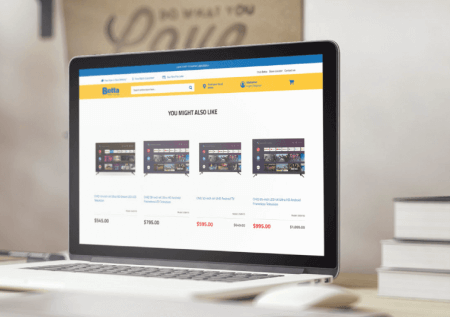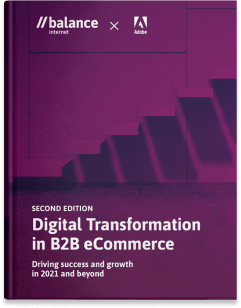eCommerce merchandising and personalisation vs In-Store
Latest news / 30 June 2021


Explore the benefits of eCommerce merchandising and personalisation.
This week on the blog, we’re sharing an excerpt from chapter 4 of 19, from the Balance Internet white paper ‘Digital Transformation in B2B eCommerce — Driving Success and Growth in 2021 and Beyond’ Second Edition.’
Brick-and-mortar businesses have long been able to wow customers with in-store merchandising and personalised experiences. However, eCommerce merchants today have several critical advantages over in-store experiences.
From sharing specialised product specifications and information to tailoring catalogues, products and prices for each customer. Here are six key advantages of eCommerce personalisation and merchandising, according to experts.
The power of merchandising and personalisation for online merchants
As B2B eCommerce businesses and technologies continue to evolve through digital transformation, merchants today have several critical advantages over in-store experiences, particularly when it comes to digital merchandising and personalisation. To drive revenue and forge strong customer relationships, B2B merchants are increasingly creating personalised online shopping experiences for ‘one’ instead of the former ‘one size fits all’ approach. Product recommendations personalise the customer experience by helping shoppers quickly and effortlessly find products relevant to their profile and behaviour.
A personalised shopping experience comes in many forms, it could simply seek to share high-quality product images and video, as well as other dynamic content, to relevant interested B2B buyers. Or instead, optimise a browsing experience based on customer browser behaviour and analytics. On average, shoppers who engage with a recommended product have a 70% higher conversion rate.
Research conducted by Marketo highlights that more than 90% of consumers are more likely to shop with brands that provide personalised offers and recommendations. They’re also willing to share their behavioural data to get them. With the purchasing experiences of B2B buyers, so heavily influenced by the way they shop in their own personal lives, it’s no wonder personalisation for B2B buyers and decision-makers is a key focus of eCommerce teams.
Throughout 2020 at Balance, we saw firsthand the importance of utilising merchandising and personalisation strategies online, as many retailers were forced to close their doors to valued B2B customers. With sales representatives grounded and unable to travel to their customers, many clients focused their attention on how their eCommerce platform could best support them. Almost all B2B eCommerce platform features worked in overdrive to focus on retaining and supporting customers. Online merchandising and personalisation were and continue to be critical elements.
In 2021 and beyond, B2B eCommerce will continue to undergo a major transformation. As companies adopt the latest technologies to find new customers, improve their supply-chain efficiencies, and provide a more personalised user experience to their clientele.
Through the interpretation of data, we cannot talk away our views on the customer experience. It is, of course, possible that things become lost in translation, which is why we must rely on alternate data sources to validate insights.
Many organisations today face an extremely tangled web of data sources and data aggregate technologies. Companies have, on average, 17 different technology applications leveraging customer data, with an average of 28 different data sources used for generating customer insights and customer engagement. In our experience, streamlining the data sources, and being able to use the various sources to validate insights or show an alternative view, remain acritical challenges in delivering a winning customer experience.
eCommerce Merchandising
Merchandising is a term used in retail to describe the art and science of floor plan development and the presentation of products. In a Magento eCommerce store, you might think of the category-based navigation as the store’s floor plan and the dynamic presentation of products as the conditions that you can apply to the listing of products in the store.
eCommerce Personalisation
Personalisation is a term used in eCommerce to describe the process of delivering personal experiences on eCommerce websites, by dynamically delivering content, offers, recommendations and other content based on the actions and behaviour of customers.
B2B merchandising and personalisation platform features
- Create and assign custom catalogues and price lists to buyers
- Create and manage multiple tailored B2B sites from a single platform
- Robust segmentation and targeting capabilities
- AI and machine learning for personalised B2B customer content experiences e.g., Adobe Sensei
- Branded customer/company portal
- Customer-specific content and offers
- Ability to set catalogues for employees (a subset of a catalogue within a company)
- Ability to hide price for customers (buying against allocation)
- Personal requisition lists – optimising ordering of frequently purchased products
- Quote negotiation functionality – allowing personalised negotiation of pricing for orders between buyer and seller
Advantages of online merchandising and personalisation vs in store
#1 – Showcase high-quality products images and videos
These days many manufacturers and B2B merchants create detailed images and videos to assist with selling products online. Many suppliers create highly technical specification images and videos, which customers can view to learn more about products. The media browser on a product page can display multiple images, videos, or swatches related to the product. Each thumbnail can show a different view or variation of the product. Of course, in person, a sales representative can communicate this information, but on a website product page, each pitch will be consistent and expertly narrated. Further, a customer can do their research online, and then request assistance for further questions and product information.
#2 – Provide a view of all product variants and comparable products
Many customers need to be able to see all options available, including product variants and comparable products. Extensive online research before a purchase has become a common practice, and customers expect to be able to find this information online.
#3 – Share highly detailed products specifications and product information
B2B merchants know that with the sale of industry-specific and niche products, highly detailed information usually accompanies the product. This information might come directly from a supplier, or be created in-house to assist with the sales process. The information can be shared with customers through an online store. The data can be stored for internal distribution in the platform, or in a PIM, for example.
#4 – Tailor catalogues, products and pricing per customer
Ensuring the online experience matches the pricing and product model that a sales representative or the account manager would deliver is paramount to the success of a B2B online store. Merchants and sales teams can tailor catalogues, products and pricing per customer, making the job of price-books and agreed pricing structures easier. This feeds into the merchandising and personalisation for a B2B customer, when they shop with you online.
#5 – Optimise the browsing experiences
Online merchandising allows merchants to optimise a customer’s browsing experience by giving the customer a ‘full view’ of products in a specific category, that may not be available in-store. This could include showcasing all product variants for a product (where only one option may be on display in a showroom), showcasing new products, or showcasing products that are out of stock or on backorder. This isn’t always possible in-store, and many customers like to have the full picture.
#6 – Collect data about customer browsing and shopping habits to improve the customer experience
Merchants can utilise data and insights about customer browsing and shopping to remerchandise their online store. Of course, remerchandising in-store is extremely common, but the online store can provide real-time data about browsing and purchases that would be close to impossible to capture in face-to-face interactions.
Conclusion
This blog post is an excerpt from chapter 4 of 19, from the Balance’s whitepaper ‘Digital Transformation in B2B eCommerce — Driving Success and Growth in 2021 and Beyond’ Second Edition.
Read the full chapter, along with expert insights and predictions from 40+ industry experts, by downloading a FREE copy of the whitepaper today.



